Importance of Managing Customer Lifecycle in CRM Practices
VerifiedAdded on 2023/06/04
|8
|2019
|477
Essay
AI Summary
This essay delves into the critical role of Customer Relationship Management (CRM) and the effective management of the customer lifecycle in fostering business success. It emphasizes that effective customer lifecycle management helps businesses retain valuable repeat customers by focusing on the approach, acquisition, development, retention, and loyalty stages. The essay highlights how CRM tools provide personalized customer experiences, improve brand reputation, and create brand advocates. The paper discusses the importance of CRM technology, including its role in data collection, analysis, and targeted marketing efforts. It also explores the product lifecycle stages and the financial benefits of retaining existing customers. The essay concludes that by leveraging CRM, businesses can build stronger customer relationships and drive sustainable growth through personalized support and communication. The essay draws upon various academic sources to support its arguments, providing a comprehensive overview of the subject.
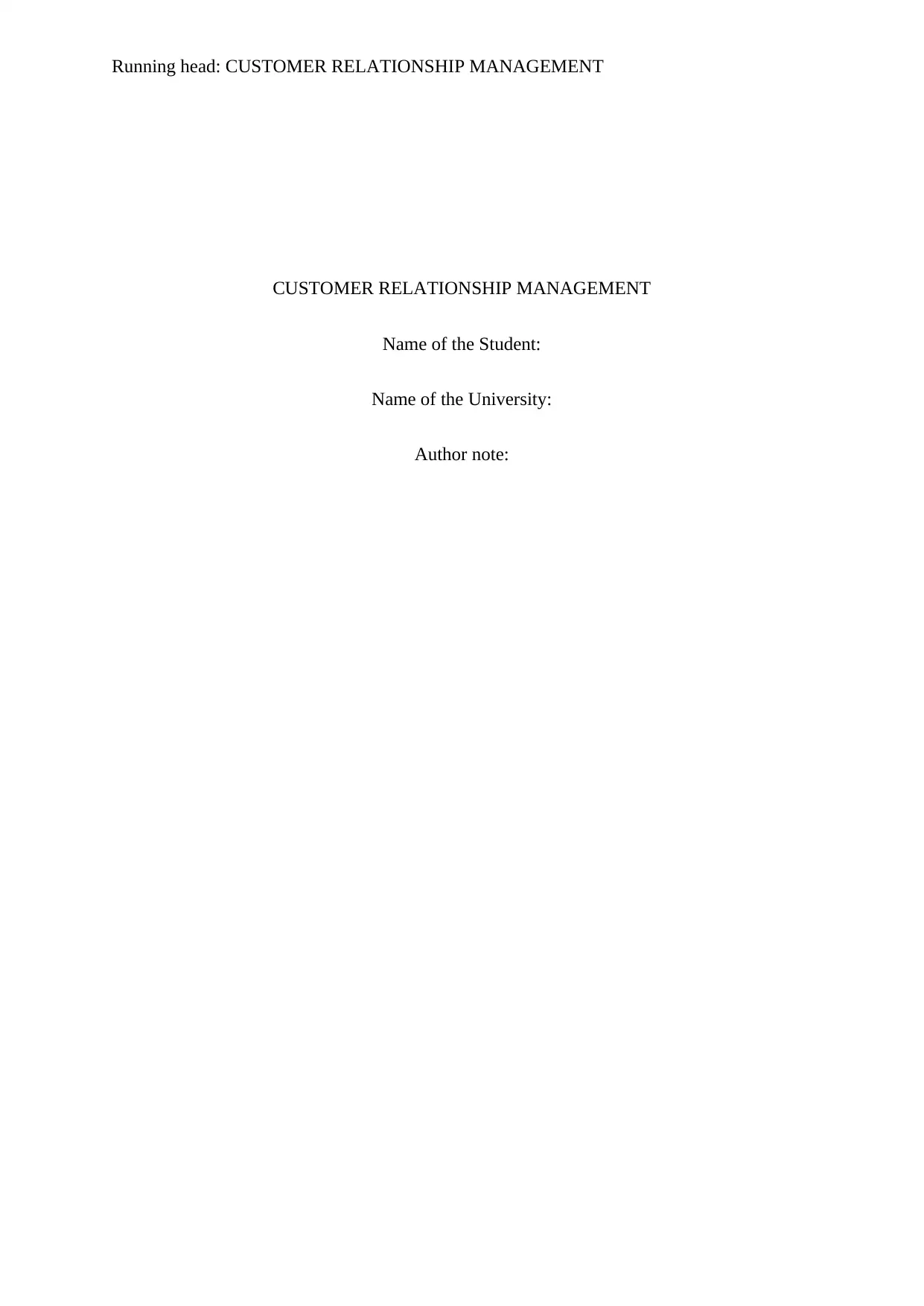
Running head: CUSTOMER RELATIONSHIP MANAGEMENT
CUSTOMER RELATIONSHIP MANAGEMENT
Name of the Student:
Name of the University:
Author note:
CUSTOMER RELATIONSHIP MANAGEMENT
Name of the Student:
Name of the University:
Author note:
Paraphrase This Document
Need a fresh take? Get an instant paraphrase of this document with our AI Paraphraser
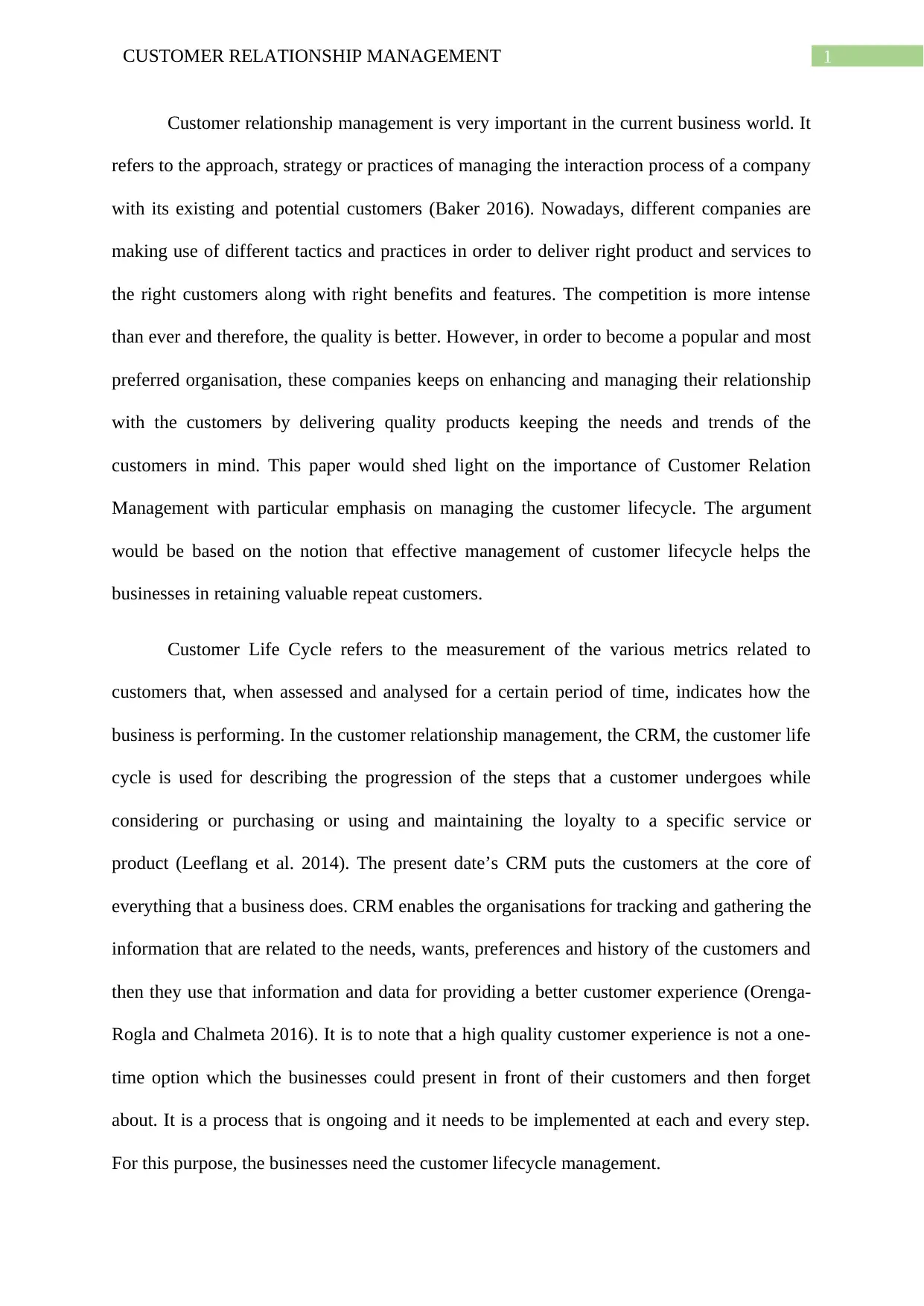
1CUSTOMER RELATIONSHIP MANAGEMENT
Customer relationship management is very important in the current business world. It
refers to the approach, strategy or practices of managing the interaction process of a company
with its existing and potential customers (Baker 2016). Nowadays, different companies are
making use of different tactics and practices in order to deliver right product and services to
the right customers along with right benefits and features. The competition is more intense
than ever and therefore, the quality is better. However, in order to become a popular and most
preferred organisation, these companies keeps on enhancing and managing their relationship
with the customers by delivering quality products keeping the needs and trends of the
customers in mind. This paper would shed light on the importance of Customer Relation
Management with particular emphasis on managing the customer lifecycle. The argument
would be based on the notion that effective management of customer lifecycle helps the
businesses in retaining valuable repeat customers.
Customer Life Cycle refers to the measurement of the various metrics related to
customers that, when assessed and analysed for a certain period of time, indicates how the
business is performing. In the customer relationship management, the CRM, the customer life
cycle is used for describing the progression of the steps that a customer undergoes while
considering or purchasing or using and maintaining the loyalty to a specific service or
product (Leeflang et al. 2014). The present date’s CRM puts the customers at the core of
everything that a business does. CRM enables the organisations for tracking and gathering the
information that are related to the needs, wants, preferences and history of the customers and
then they use that information and data for providing a better customer experience (Orenga-
Rogla and Chalmeta 2016). It is to note that a high quality customer experience is not a one-
time option which the businesses could present in front of their customers and then forget
about. It is a process that is ongoing and it needs to be implemented at each and every step.
For this purpose, the businesses need the customer lifecycle management.
Customer relationship management is very important in the current business world. It
refers to the approach, strategy or practices of managing the interaction process of a company
with its existing and potential customers (Baker 2016). Nowadays, different companies are
making use of different tactics and practices in order to deliver right product and services to
the right customers along with right benefits and features. The competition is more intense
than ever and therefore, the quality is better. However, in order to become a popular and most
preferred organisation, these companies keeps on enhancing and managing their relationship
with the customers by delivering quality products keeping the needs and trends of the
customers in mind. This paper would shed light on the importance of Customer Relation
Management with particular emphasis on managing the customer lifecycle. The argument
would be based on the notion that effective management of customer lifecycle helps the
businesses in retaining valuable repeat customers.
Customer Life Cycle refers to the measurement of the various metrics related to
customers that, when assessed and analysed for a certain period of time, indicates how the
business is performing. In the customer relationship management, the CRM, the customer life
cycle is used for describing the progression of the steps that a customer undergoes while
considering or purchasing or using and maintaining the loyalty to a specific service or
product (Leeflang et al. 2014). The present date’s CRM puts the customers at the core of
everything that a business does. CRM enables the organisations for tracking and gathering the
information that are related to the needs, wants, preferences and history of the customers and
then they use that information and data for providing a better customer experience (Orenga-
Rogla and Chalmeta 2016). It is to note that a high quality customer experience is not a one-
time option which the businesses could present in front of their customers and then forget
about. It is a process that is ongoing and it needs to be implemented at each and every step.
For this purpose, the businesses need the customer lifecycle management.
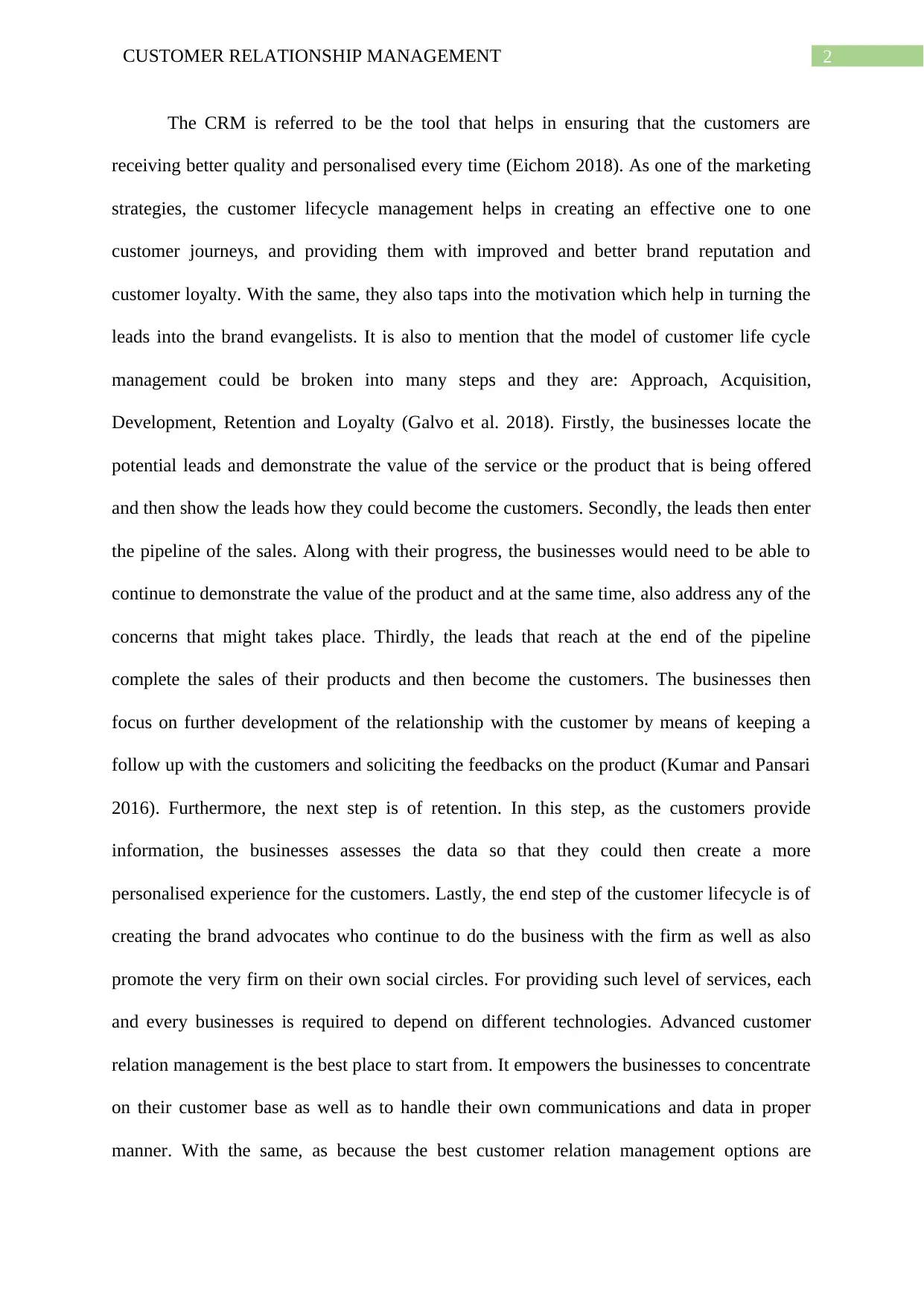
2CUSTOMER RELATIONSHIP MANAGEMENT
The CRM is referred to be the tool that helps in ensuring that the customers are
receiving better quality and personalised every time (Eichom 2018). As one of the marketing
strategies, the customer lifecycle management helps in creating an effective one to one
customer journeys, and providing them with improved and better brand reputation and
customer loyalty. With the same, they also taps into the motivation which help in turning the
leads into the brand evangelists. It is also to mention that the model of customer life cycle
management could be broken into many steps and they are: Approach, Acquisition,
Development, Retention and Loyalty (Galvo et al. 2018). Firstly, the businesses locate the
potential leads and demonstrate the value of the service or the product that is being offered
and then show the leads how they could become the customers. Secondly, the leads then enter
the pipeline of the sales. Along with their progress, the businesses would need to be able to
continue to demonstrate the value of the product and at the same time, also address any of the
concerns that might takes place. Thirdly, the leads that reach at the end of the pipeline
complete the sales of their products and then become the customers. The businesses then
focus on further development of the relationship with the customer by means of keeping a
follow up with the customers and soliciting the feedbacks on the product (Kumar and Pansari
2016). Furthermore, the next step is of retention. In this step, as the customers provide
information, the businesses assesses the data so that they could then create a more
personalised experience for the customers. Lastly, the end step of the customer lifecycle is of
creating the brand advocates who continue to do the business with the firm as well as also
promote the very firm on their own social circles. For providing such level of services, each
and every businesses is required to depend on different technologies. Advanced customer
relation management is the best place to start from. It empowers the businesses to concentrate
on their customer base as well as to handle their own communications and data in proper
manner. With the same, as because the best customer relation management options are
The CRM is referred to be the tool that helps in ensuring that the customers are
receiving better quality and personalised every time (Eichom 2018). As one of the marketing
strategies, the customer lifecycle management helps in creating an effective one to one
customer journeys, and providing them with improved and better brand reputation and
customer loyalty. With the same, they also taps into the motivation which help in turning the
leads into the brand evangelists. It is also to mention that the model of customer life cycle
management could be broken into many steps and they are: Approach, Acquisition,
Development, Retention and Loyalty (Galvo et al. 2018). Firstly, the businesses locate the
potential leads and demonstrate the value of the service or the product that is being offered
and then show the leads how they could become the customers. Secondly, the leads then enter
the pipeline of the sales. Along with their progress, the businesses would need to be able to
continue to demonstrate the value of the product and at the same time, also address any of the
concerns that might takes place. Thirdly, the leads that reach at the end of the pipeline
complete the sales of their products and then become the customers. The businesses then
focus on further development of the relationship with the customer by means of keeping a
follow up with the customers and soliciting the feedbacks on the product (Kumar and Pansari
2016). Furthermore, the next step is of retention. In this step, as the customers provide
information, the businesses assesses the data so that they could then create a more
personalised experience for the customers. Lastly, the end step of the customer lifecycle is of
creating the brand advocates who continue to do the business with the firm as well as also
promote the very firm on their own social circles. For providing such level of services, each
and every businesses is required to depend on different technologies. Advanced customer
relation management is the best place to start from. It empowers the businesses to concentrate
on their customer base as well as to handle their own communications and data in proper
manner. With the same, as because the best customer relation management options are
⊘ This is a preview!⊘
Do you want full access?
Subscribe today to unlock all pages.

Trusted by 1+ million students worldwide
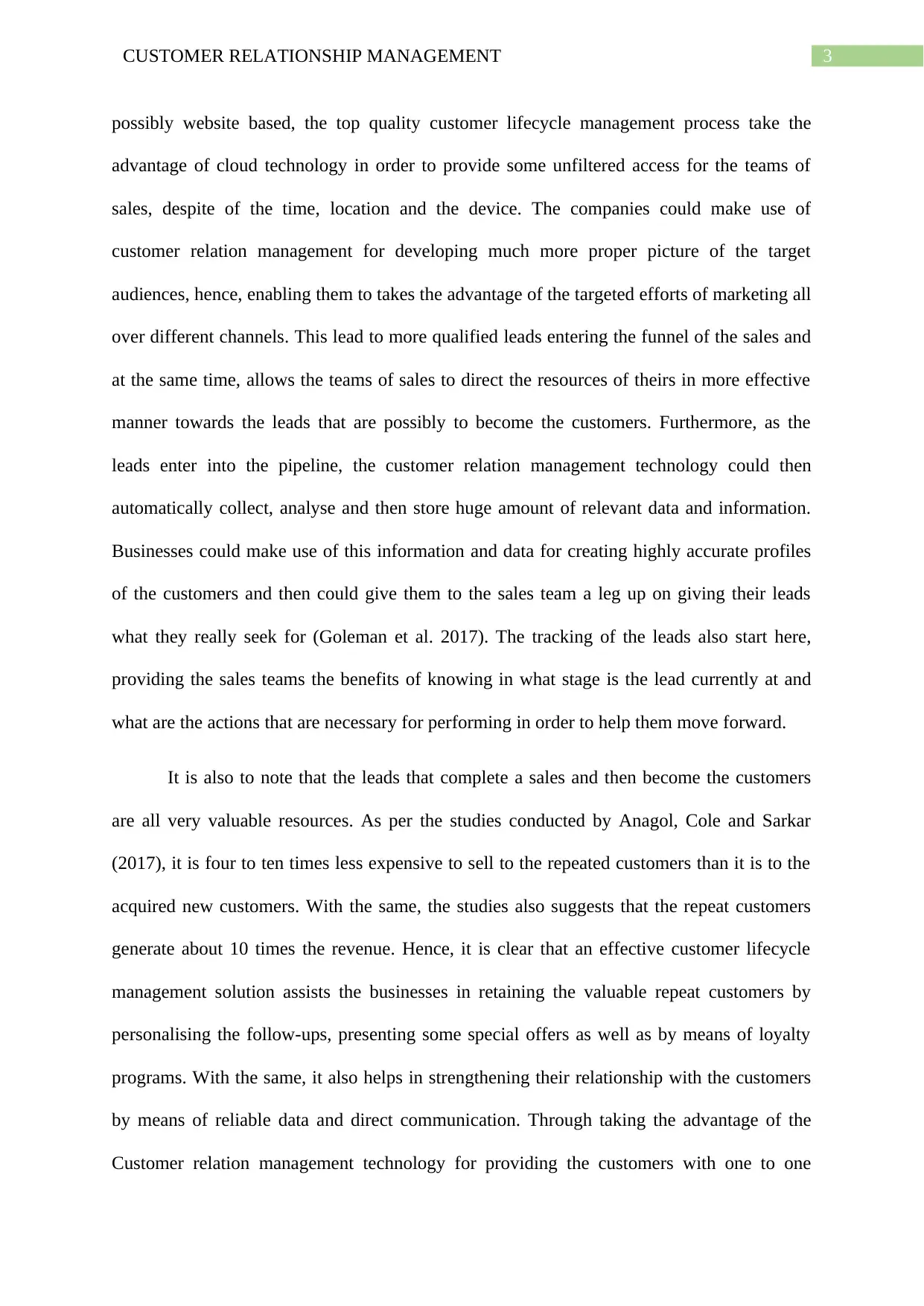
3CUSTOMER RELATIONSHIP MANAGEMENT
possibly website based, the top quality customer lifecycle management process take the
advantage of cloud technology in order to provide some unfiltered access for the teams of
sales, despite of the time, location and the device. The companies could make use of
customer relation management for developing much more proper picture of the target
audiences, hence, enabling them to takes the advantage of the targeted efforts of marketing all
over different channels. This lead to more qualified leads entering the funnel of the sales and
at the same time, allows the teams of sales to direct the resources of theirs in more effective
manner towards the leads that are possibly to become the customers. Furthermore, as the
leads enter into the pipeline, the customer relation management technology could then
automatically collect, analyse and then store huge amount of relevant data and information.
Businesses could make use of this information and data for creating highly accurate profiles
of the customers and then could give them to the sales team a leg up on giving their leads
what they really seek for (Goleman et al. 2017). The tracking of the leads also start here,
providing the sales teams the benefits of knowing in what stage is the lead currently at and
what are the actions that are necessary for performing in order to help them move forward.
It is also to note that the leads that complete a sales and then become the customers
are all very valuable resources. As per the studies conducted by Anagol, Cole and Sarkar
(2017), it is four to ten times less expensive to sell to the repeated customers than it is to the
acquired new customers. With the same, the studies also suggests that the repeat customers
generate about 10 times the revenue. Hence, it is clear that an effective customer lifecycle
management solution assists the businesses in retaining the valuable repeat customers by
personalising the follow-ups, presenting some special offers as well as by means of loyalty
programs. With the same, it also helps in strengthening their relationship with the customers
by means of reliable data and direct communication. Through taking the advantage of the
Customer relation management technology for providing the customers with one to one
possibly website based, the top quality customer lifecycle management process take the
advantage of cloud technology in order to provide some unfiltered access for the teams of
sales, despite of the time, location and the device. The companies could make use of
customer relation management for developing much more proper picture of the target
audiences, hence, enabling them to takes the advantage of the targeted efforts of marketing all
over different channels. This lead to more qualified leads entering the funnel of the sales and
at the same time, allows the teams of sales to direct the resources of theirs in more effective
manner towards the leads that are possibly to become the customers. Furthermore, as the
leads enter into the pipeline, the customer relation management technology could then
automatically collect, analyse and then store huge amount of relevant data and information.
Businesses could make use of this information and data for creating highly accurate profiles
of the customers and then could give them to the sales team a leg up on giving their leads
what they really seek for (Goleman et al. 2017). The tracking of the leads also start here,
providing the sales teams the benefits of knowing in what stage is the lead currently at and
what are the actions that are necessary for performing in order to help them move forward.
It is also to note that the leads that complete a sales and then become the customers
are all very valuable resources. As per the studies conducted by Anagol, Cole and Sarkar
(2017), it is four to ten times less expensive to sell to the repeated customers than it is to the
acquired new customers. With the same, the studies also suggests that the repeat customers
generate about 10 times the revenue. Hence, it is clear that an effective customer lifecycle
management solution assists the businesses in retaining the valuable repeat customers by
personalising the follow-ups, presenting some special offers as well as by means of loyalty
programs. With the same, it also helps in strengthening their relationship with the customers
by means of reliable data and direct communication. Through taking the advantage of the
Customer relation management technology for providing the customers with one to one
Paraphrase This Document
Need a fresh take? Get an instant paraphrase of this document with our AI Paraphraser
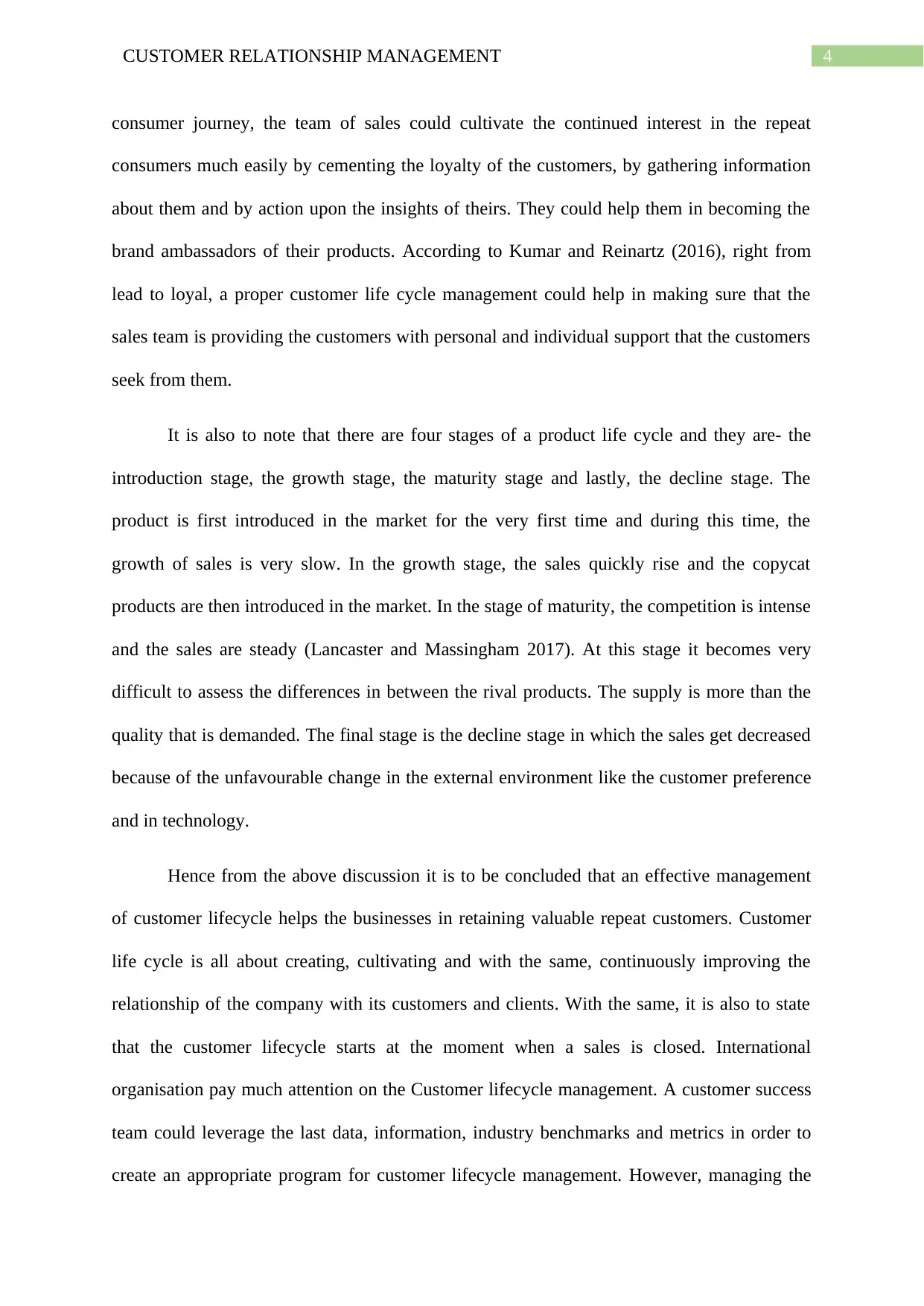
4CUSTOMER RELATIONSHIP MANAGEMENT
consumer journey, the team of sales could cultivate the continued interest in the repeat
consumers much easily by cementing the loyalty of the customers, by gathering information
about them and by action upon the insights of theirs. They could help them in becoming the
brand ambassadors of their products. According to Kumar and Reinartz (2016), right from
lead to loyal, a proper customer life cycle management could help in making sure that the
sales team is providing the customers with personal and individual support that the customers
seek from them.
It is also to note that there are four stages of a product life cycle and they are- the
introduction stage, the growth stage, the maturity stage and lastly, the decline stage. The
product is first introduced in the market for the very first time and during this time, the
growth of sales is very slow. In the growth stage, the sales quickly rise and the copycat
products are then introduced in the market. In the stage of maturity, the competition is intense
and the sales are steady (Lancaster and Massingham 2017). At this stage it becomes very
difficult to assess the differences in between the rival products. The supply is more than the
quality that is demanded. The final stage is the decline stage in which the sales get decreased
because of the unfavourable change in the external environment like the customer preference
and in technology.
Hence from the above discussion it is to be concluded that an effective management
of customer lifecycle helps the businesses in retaining valuable repeat customers. Customer
life cycle is all about creating, cultivating and with the same, continuously improving the
relationship of the company with its customers and clients. With the same, it is also to state
that the customer lifecycle starts at the moment when a sales is closed. International
organisation pay much attention on the Customer lifecycle management. A customer success
team could leverage the last data, information, industry benchmarks and metrics in order to
create an appropriate program for customer lifecycle management. However, managing the
consumer journey, the team of sales could cultivate the continued interest in the repeat
consumers much easily by cementing the loyalty of the customers, by gathering information
about them and by action upon the insights of theirs. They could help them in becoming the
brand ambassadors of their products. According to Kumar and Reinartz (2016), right from
lead to loyal, a proper customer life cycle management could help in making sure that the
sales team is providing the customers with personal and individual support that the customers
seek from them.
It is also to note that there are four stages of a product life cycle and they are- the
introduction stage, the growth stage, the maturity stage and lastly, the decline stage. The
product is first introduced in the market for the very first time and during this time, the
growth of sales is very slow. In the growth stage, the sales quickly rise and the copycat
products are then introduced in the market. In the stage of maturity, the competition is intense
and the sales are steady (Lancaster and Massingham 2017). At this stage it becomes very
difficult to assess the differences in between the rival products. The supply is more than the
quality that is demanded. The final stage is the decline stage in which the sales get decreased
because of the unfavourable change in the external environment like the customer preference
and in technology.
Hence from the above discussion it is to be concluded that an effective management
of customer lifecycle helps the businesses in retaining valuable repeat customers. Customer
life cycle is all about creating, cultivating and with the same, continuously improving the
relationship of the company with its customers and clients. With the same, it is also to state
that the customer lifecycle starts at the moment when a sales is closed. International
organisation pay much attention on the Customer lifecycle management. A customer success
team could leverage the last data, information, industry benchmarks and metrics in order to
create an appropriate program for customer lifecycle management. However, managing the

5CUSTOMER RELATIONSHIP MANAGEMENT
customer lifecycle in effective manner could help in building of the ground work in order to
optimise the internal procedures and processes. By means of streaming the interdepartmental
handoffs as well as by tracking the critical metrics like the employee time spent and the
overall results, managing customer lifecycle management opens up new opportunities or new
world for the customer success professionals.
customer lifecycle in effective manner could help in building of the ground work in order to
optimise the internal procedures and processes. By means of streaming the interdepartmental
handoffs as well as by tracking the critical metrics like the employee time spent and the
overall results, managing customer lifecycle management opens up new opportunities or new
world for the customer success professionals.
⊘ This is a preview!⊘
Do you want full access?
Subscribe today to unlock all pages.

Trusted by 1+ million students worldwide
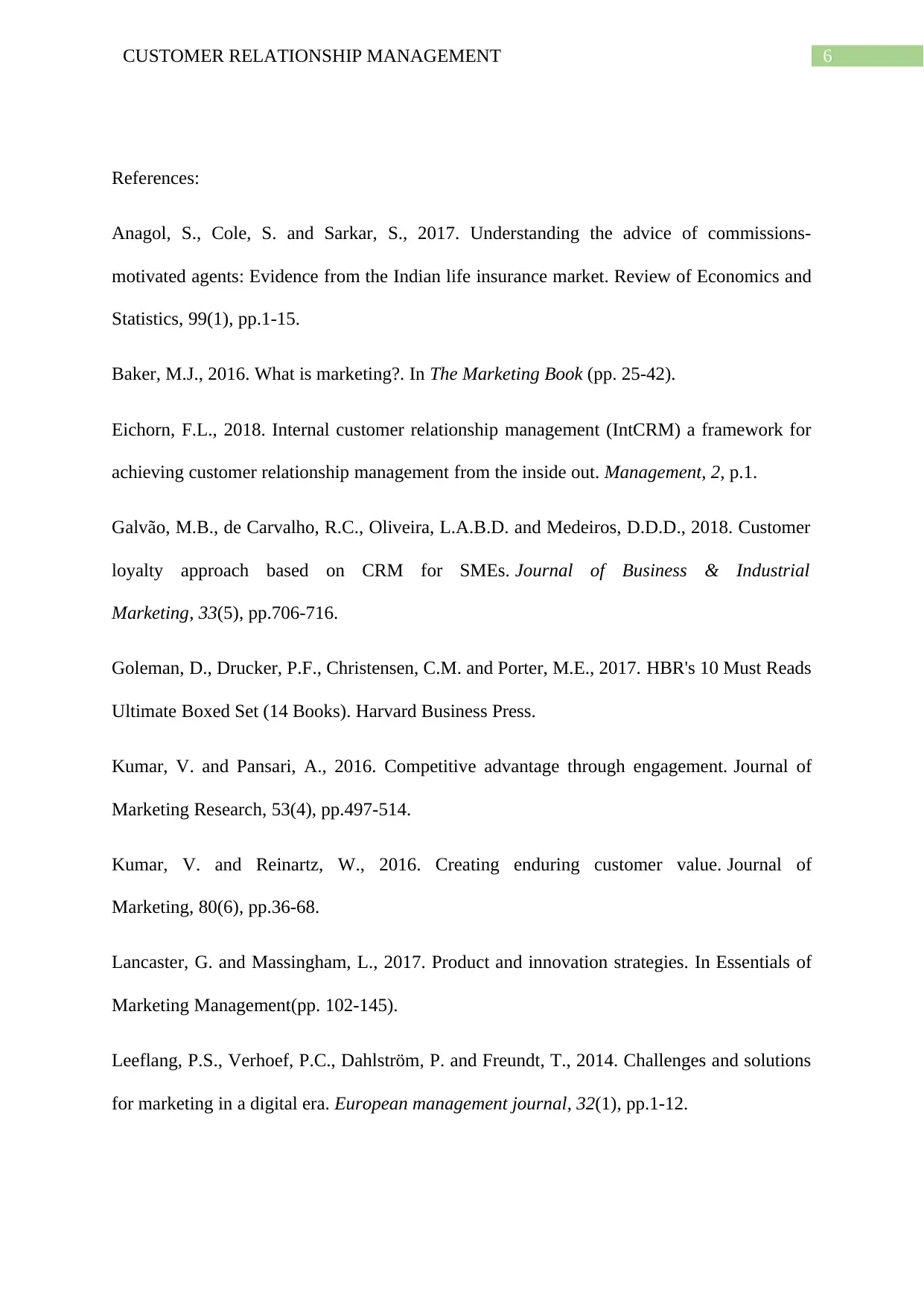
6CUSTOMER RELATIONSHIP MANAGEMENT
References:
Anagol, S., Cole, S. and Sarkar, S., 2017. Understanding the advice of commissions-
motivated agents: Evidence from the Indian life insurance market. Review of Economics and
Statistics, 99(1), pp.1-15.
Baker, M.J., 2016. What is marketing?. In The Marketing Book (pp. 25-42).
Eichorn, F.L., 2018. Internal customer relationship management (IntCRM) a framework for
achieving customer relationship management from the inside out. Management, 2, p.1.
Galvão, M.B., de Carvalho, R.C., Oliveira, L.A.B.D. and Medeiros, D.D.D., 2018. Customer
loyalty approach based on CRM for SMEs. Journal of Business & Industrial
Marketing, 33(5), pp.706-716.
Goleman, D., Drucker, P.F., Christensen, C.M. and Porter, M.E., 2017. HBR's 10 Must Reads
Ultimate Boxed Set (14 Books). Harvard Business Press.
Kumar, V. and Pansari, A., 2016. Competitive advantage through engagement. Journal of
Marketing Research, 53(4), pp.497-514.
Kumar, V. and Reinartz, W., 2016. Creating enduring customer value. Journal of
Marketing, 80(6), pp.36-68.
Lancaster, G. and Massingham, L., 2017. Product and innovation strategies. In Essentials of
Marketing Management(pp. 102-145).
Leeflang, P.S., Verhoef, P.C., Dahlström, P. and Freundt, T., 2014. Challenges and solutions
for marketing in a digital era. European management journal, 32(1), pp.1-12.
References:
Anagol, S., Cole, S. and Sarkar, S., 2017. Understanding the advice of commissions-
motivated agents: Evidence from the Indian life insurance market. Review of Economics and
Statistics, 99(1), pp.1-15.
Baker, M.J., 2016. What is marketing?. In The Marketing Book (pp. 25-42).
Eichorn, F.L., 2018. Internal customer relationship management (IntCRM) a framework for
achieving customer relationship management from the inside out. Management, 2, p.1.
Galvão, M.B., de Carvalho, R.C., Oliveira, L.A.B.D. and Medeiros, D.D.D., 2018. Customer
loyalty approach based on CRM for SMEs. Journal of Business & Industrial
Marketing, 33(5), pp.706-716.
Goleman, D., Drucker, P.F., Christensen, C.M. and Porter, M.E., 2017. HBR's 10 Must Reads
Ultimate Boxed Set (14 Books). Harvard Business Press.
Kumar, V. and Pansari, A., 2016. Competitive advantage through engagement. Journal of
Marketing Research, 53(4), pp.497-514.
Kumar, V. and Reinartz, W., 2016. Creating enduring customer value. Journal of
Marketing, 80(6), pp.36-68.
Lancaster, G. and Massingham, L., 2017. Product and innovation strategies. In Essentials of
Marketing Management(pp. 102-145).
Leeflang, P.S., Verhoef, P.C., Dahlström, P. and Freundt, T., 2014. Challenges and solutions
for marketing in a digital era. European management journal, 32(1), pp.1-12.
Paraphrase This Document
Need a fresh take? Get an instant paraphrase of this document with our AI Paraphraser

7CUSTOMER RELATIONSHIP MANAGEMENT
Orenga-Roglá, S. and Chalmeta, R., 2016. Social customer relationship management: taking
advantage of Web 2.0 and Big Data technologies. SpringerPlus, 5(1), p.1462.
Orenga-Roglá, S. and Chalmeta, R., 2016. Social customer relationship management: taking
advantage of Web 2.0 and Big Data technologies. SpringerPlus, 5(1), p.1462.
1 out of 8
Related Documents
Your All-in-One AI-Powered Toolkit for Academic Success.
+13062052269
info@desklib.com
Available 24*7 on WhatsApp / Email
![[object Object]](/_next/static/media/star-bottom.7253800d.svg)
Unlock your academic potential
Copyright © 2020–2025 A2Z Services. All Rights Reserved. Developed and managed by ZUCOL.





